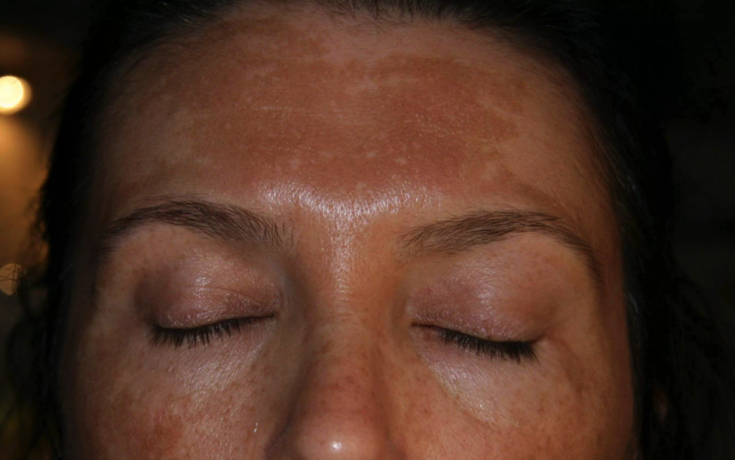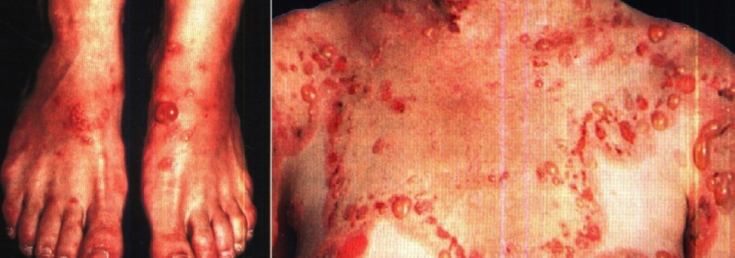As a result of the rapidly changing hormonal background of a pregnant woman, dermatological pathology is difficult to diagnose in a timely manner and clearly determine the etiology. In case of a violation of the hormonal status, pathological changes in the skin and mucous membranes may develop, due to the presence of estrogen and progesterone receptors. It is important to understand the mechanism of action of gestational changes in order to choose the right tactics for the management of such patients and determine the need for correction. Let's take a look at estet-portal.com possible dermatological manifestations during pregnancy.
- Dyschromia as a manifestation of hormonal changes during pregnancy
- Polymorphic dermatosis of pregnant women: characteristics
- Autoimmune progesterone dermatitis during pregnancy
- Pemphigoid gestationis: clinical picture
Dyschromia as a manifestation of hormonal changes during pregnancy
The development of hyperpigmentation during pregnancy is a consequence of the increase of melanocyte-stimulating hormone as well as the stimulation of estrogen receptors in the skin.
Follow us on Instagram!
Pigment is most often deposited in the area of the skin of the nipples, areolas, white line of the abdomen, external genital organs, as well as on the inner surface of the thighs.
Read also: Peeling against hyperpigmentation
The severity of birthmarks, pigmentation of nevi, fresh scars also increase. Regression usually occurs after delivery.

Chloasma is observed on the skin of the face in the form of symmetrical brown spots of varying intensity: located on the cheeks, on the forehead, less often – on the upper lip. The physiological increase in estrogens and progesterone plays a key role in the pathogenesis of the disease.
Read also: Cosmetic procedures for the correction of chloasma
An important role in the pathogenesis of masks of pregnant women is also the influence of ultraviolet radiation. It is believed that folic acid deficiency is also involved in the development of this pathology. Differential diagnosis of chloasma should be performed with post-inflammatory pigmentation.
Polymorphic dermatosis of pregnant women: characteristics
In 76% of cases, pruritic urticarial papules and plaques of pregnancy manifest themselves in the third trimester during the first pregnancy and regress within 7-10 days after delivery.
There are certain factors that accompany the development of polymorphic dermatosis: onset in the third trimester, primarily occur in the abdomen, large body weight in pregnant women with a similar pathology.
First, the skin of the lower third of the abdomen is affected. In most cases, primary elements develop in stretch marks, then spread to the chest, back, and limbs. Patients complain of itching in the abdomen, thighs, buttocks. Eruptions are erythematous swollen papules 1-3 mm in diameter. They tend to merge, turn pale when pressed, itch, form plaques, on the surface of which vesicles are observed in 40% of cases. By biopsy of the affected areas reveal perivascular lymphohistiocytic infiltration in the upper layers of the dermis, edema of the papillary layer, focal keratosis and spongiosis.
Autoimmune progesterone dermatitis during pregnancy
The pathogenesis of autoimmune progesterone dermatitis is not fully known, however, the mechanism of development is probably associated with the development of hypersensitivity to progesterone with an increase in its level in the blood serum during pregnancy .
Read also:Allergic spots: clinic, treatment
Clinically the disease resembles the manifestations of urticaria, there are areas of hyperemia and peeling, it may look like erythema multiforme, dyshidrotic lesions. Most often, rashes appear on the palms, less often – on the feet, on the body. There may be vesicles on the palms.
Autoimmune progesterone dermatitis can also occur in non-pregnant women while taking progestin drugs.
In this case, the rash appears 5-10 days before menstruation pass after a few days.
Gestationis pemphigoid: clinical picture
"Herpes pregnancy" has nothing to do with herpes virus infection. This is a rare autoimmune bullous skin lesion during pregnancy associated with the presence of circulating antibodies to skin basement membrane antigens.
Read also: Genital herpes: treatment tactics
Herpes pregnant is also associated with tissue and serum HLA-DR3, especially with HLA-DR3 and HLA-DR4 compounds.
Follow us on Facebook!
The onset of the disease mainly occurs in the second and third trimester of pregnancy, but can develop at any time.

The prodromal period in pemphigoid is represented by common symptoms: headache, weakness, nausea, hyperthermia. A specific feature are polymorphic vesiculo-bullous elements on the background of erythema. Among the lesions, urticarial papules and plaques in the form of targets are also observed. Most often, primary elements are found in the area near the navel, but they can also have a generalized character: erythematous papules and vesicles appear on the buttocks, limbs, mucous membranes.
Read also: Uterine prolapse: etiology, clinic, surgery
On the extensor surfaces of the limbs, the elements are located in rings. biopsy reveals perivascular, eosinophilic, lymphocytic and histiocytic infiltration of the superficial and deep layers of the skin. In the course of the disease, edema of the papillary dermis develops with detachment of the basal cells of the epidermis from the basement membrane. In the blood, complement-fixing factor of herpes of pregnant women is determined – factor GB.
Competent interpretation of pathological changes in the skin in women during pregnancy will help to competently assess the relationship of specific manifestations with the state of body systems, water-salt and electrolyte balance, determine the need for pathological correction and effectively build a treatment strategy.
More interesting stuff on our YouTube channel:







Add a comment